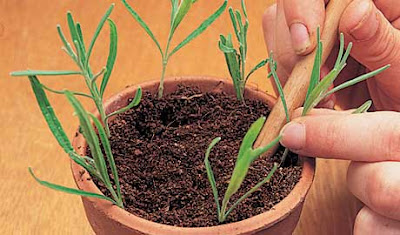 |
| How to propagate lavender from cuttings |
Lavender plants are one of the world's most popular garden plants, and why wouldn't they be? Evergreen, tough as old boots, soft, silvery foliage and gorgeous scented flowers - it is truly a plant for everyone. Of course, buying lavender can prove expensive, but luckily they are very easy to take cuttings from so long as you have the right tools and equipment.
Taking cuttings from lavender is surprisingly easy so long as you take them at the right time of year. Luckily you will get two bites of the cherry as you can take lavender cuttings either in the spring (just before the plant comes into flower), or in the autumn around August time.
Lavender has been propagated by cuttings for thousands of years which proves its ease of production, so I will keep the technique 'old school' as I know this way works. Start by using 3 inch terracotta pots, filled with a good quality compost such as John Innes 'Seed and Cutting'. You can even make your own compost by mixing approximately 3 parts peat moss with 1 part horticultural grit or vermiculite. The most important thing here is that the compost is well drained. Dampen the mixture then poke a small hole about 1 to 1½ inches deep into the soil into which you will plant your 'freshly-cut' cuttings.
How to take a lavender cutting
 |
| How to propagate lavender from cuttings |
Using a sharp, sterilised knife or secateurs, cut a small branch off the lower half of the plant that is about 3-5 inches long.
Make sure that the branch is soft and not woody. Strip the bottom half of the cutting of leaves, place in the hole in the soil that you prepared earlier then close the hole with soil. There is no need to use rooting hormone on lavender cuttings, but no harm will be done if you are addicted to using it.
Water your new plant thoroughly after planting. For the first couple of weeks keep the soil damp, but then water less frequently. At this point water when the top couple of inches of soil dries off, but before the plant displays any distress. Too much water will easily kill your new lavender plant. When attempting to propagate lavender, this is the most common mistake.
 |
| How to propagate lavender from cuttings |
Lavender will perform best in relatively poor, well drained soils in full sun. Prune back to shape come August but no later than the end of September.
Little known fact: In Roman times lavender was an important as part of traditional bathing rituals due to the plants disinfectant and antiseptic properties. So this makes sense when you realize that the name 'lavender' originates from Latin verb 'lavare', meaning 'to wash'.
Main image credit - Kemal ATLI https://creativecommons.org/licenses/by-sa/2.0/deed.en
GROW LAVENDER SEED
HOW TO CONTROL CUCKOO SPIT ON LAVENDER
HOW TO GROW LAVENDER
HOW TO GROW LAVENDER FROM SEED
HOW TO GROW THE VIRGINIA CREEPER FROM CUTTINGS
HOW TO PROPAGATE ABUTILON FROM CUTTINGS
HOW TO PROPAGATE BOX HEDGING PLANTS
HOW TO PROPAGATE LAVENDER FROM CUTTINGS
HOW TO TAKE CUTTINGS FROM BOX HEDGING
HOW TO TAKE CHRYSANTHEMUM CUTTINGS
HOW TO TAKE CUTTINGS OF ABELIA
HOW TO TAKE CUTTINGS FROM CAMELLIA
HOW TO TAKE CUTTINGS FROM CLEMATIS
HOW TO TAKE CUTTINGS FROM GARDENIAS
HOW TO TAKE CUTTINGS FROM ROSEMARY
How to Take Hardwood Cuttings
LAVENDER
WHAT IS LAVENDER OIL?
WHEN AND HOW SHOULD YOU PRUNE BACK LAVENDER?
WHEN TO PLANT LAVENDER?
WHY HAS MY LAVENDER DIED?
WHY HAS MY LAVENDER TURNED WOODY?







No comments:
Post a Comment